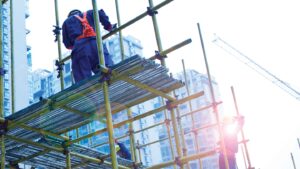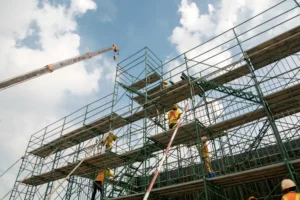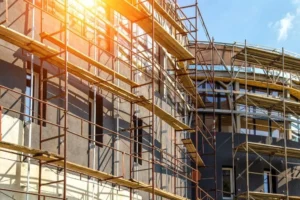Introduction:
When planning a home renovation in Bristol, scaffolding is often essential for tasks like roofing, painting, or extensions. However, unsafe scaffolding can lead to accidents, delays, and costly repairs. Ensuring safety is critical to protect workers, residents, and your property. This guide provides the top five safety tips for local scaffolding contractors in Bristol, offering practical solutions to common risks. Whether you’re a homeowner in Clifton or a builder in Bedminster, these tips will help you achieve a secure and successful renovation project.
Core Information: Why Scaffolding Safety Matters in Bristol
Scaffolding accidents are a leading cause of construction injuries in the UK, with over 4,000 incidents reported annually, according to the Health and Safety Executive (HSE). In Bristol, where historic homes and modern builds coexist, scaffolding must meet strict regulations to ensure safety. By following these five expert-recommended tips, you can minimise risks and keep your renovation on track.
Problem-Solution Guide: Top 5 Safety Tips for Local Scaffolding Contractors

Problem 1: Unqualified Local Scaffolding Contractors Risk Safety
Hiring untrained or uncertified contractors can lead to poorly erected scaffolding, increasing the chance of collapses or falls. In Bristol, where renovations often involve complex structures like Georgian terraces, expertise is non-negotiable.
Solution: Choose CITB-Certified Professionals
- Step 1: Verify the contractor’s credentials. Look for Construction Industry Training Board (CITB) or Construction Skills Certification Scheme (CSCS) certifications, which ensure training in safe scaffolding practices.
- Step 2: Ask for proof of experience with domestic scaffolding projects, especially in Bristol’s diverse neighborhoods like Redland or St Pauls.
- Step 3: Request references or check online reviews on platforms like Google Business Profile to confirm reliability.
- Example: A Clifton homeowner avoided disaster by hiring a CITB-certified team who identified weak points in their old scaffolding setup, preventing a potential collapse during a roofing project.
Problem 2: Improper Scaffold Design Leads to Instability
Poorly designed scaffolding, such as inadequate bracing or incorrect load calculations, can cause structural failure. For Bristol renovations, where narrow streets and uneven terrain are common, stable design is crucial.
Solution: Ensure Robust Scaffold Design
- Step 1: Work with local scaffolding contractors who use industry-standard systems like HAKI loading towers or traditional putlog scaffolding, tailored to your project’s needs.
- Step 2: Confirm the scaffold design complies with HSE regulations, including proper base plates and tie-ins to prevent tipping.
- Step 3: Request a site inspection to assess ground conditions, especially for Bristol’s hilly areas like Totterdown.
- Example: In a recent Bedminster renovation, a scaffold design company used HAKI stairs with precise dimensions to ensure safe access on a sloped site, reducing fall risks.
Problem 3: Lack of Regular Inspections Causes Hidden Dangers
Uninspected scaffolding can develop issues like loose fittings or weather-related damage, especially during Bristol’s wet winters. Unaddressed problems can compromise safety.

Solution: Schedule Regular Inspections
- Step 1: Ensure your contractor conducts a pre-use inspection and weekly checks, as mandated by the Work at Height Regulations 2005.
- Step 2: Verify that inspections cover key components like guardrails, toeboards, and scaffold ties.
- Step 3: Keep a log of inspection reports for accountability, especially for long-term projects like home extensions.
- Example: A Southville homeowner discovered a loose brace during a routine inspection, which was fixed promptly, preventing a potential accident during exterior painting.
Problem 4: Inadequate Access Points Increase Fall Risks
Unsafe access to scaffolding, such as missing ladders or improper staircases, is a common cause of falls. In Bristol’s compact urban homes, safe access is often challenging.
Solution: Use Safe Access Systems
- Step 1: Ensure scaffolding includes secure access points like HAKI staircase gates or robust ladders, designed for safe entry and exit.
- Step 2: Confirm that access points are clear of debris and well-lit, especially for evening work.
- Step 3: Train workers or residents on proper use of access systems to avoid misuse.
- Example: A St Andrews renovation project used HAKI loading towers with staircase gates, allowing safe access for roofers working on a steep-pitched roof.
Problem 5: Overloading Scaffolding Causes Collapses
Exceeding the weight capacity of scaffolding, such as stacking too many materials, can lead to catastrophic collapses. This is a risk in Bristol, where renovations often involve heavy materials like slate tiles.
Solution: Adhere to Load Limits
- Step 1: Confirm the scaffolding’s maximum load capacity with your contractor, typically outlined in the scaffold design plan.
- Step 2: Avoid storing excessive materials on platforms; use designated storage areas on the ground.
- Step 3: Monitor weather conditions, as wind or rain can add stress to loaded scaffolding.
- Example: During a Cotham renovation, a contractor used double scaffolding with clear load limits, ensuring safe handling of heavy roofing materials without overloading.
Real-Life Story: A Bristol Renovation Success
In 2024, a homeowner in Redland, Bristol, planned a major roof replacement on their Victorian terrace. Initially, they hired an uncertified contractor to save costs, but the scaffolding was unstable, leading to a near-miss when a worker slipped. After switching to a CITB-certified team, the project was completed safely. The new contractor used HAKI loading towers, conducted weekly inspections, and ensured proper load distribution, finishing the project ahead of schedule with zero incidents. This case highlights the importance of prioritising safety in Bristol’s home renovations.

Contextual Relevance
Scaffolding safety extends beyond these tips. Consider related factors like weatherproofing for Bristol’s rainy climate, compliance with local council permits, and training for workers. Using systems like putlog scaffolding for smaller projects or double scaffolding for larger renovations ensures flexibility. For complex projects, such as those in Bristol’s historic areas, consult local scaffolding contractors familiar with local challenges, like narrow streets or listed building restrictions. These elements enhance safety and project efficiency.
FAQs
Q: What qualifications should I look for in a Bristol local scaffolding contractors?
A: Look for CITB or CSCS certifications, which ensure training in safe scaffolding practices. Check for experience with domestic projects and local reviews.
Q: How often should scaffolding be inspected during a renovation?
A: Scaffolding must be inspected before use and weekly thereafter, per HSE regulations. Additional checks are needed after severe weather or modifications.
Q: What is the safest scaffolding system for home renovations?
A: Systems like HAKI loading towers or traditional putlog scaffolding are safe when designed and installed by certified professionals, tailored to your project’s needs.
Q: Can I store materials on scaffolding during a Bristol renovation?
A: Yes, but only within the scaffold’s load capacity. Avoid overloading and use ground storage for heavy materials to maintain safety.
Q: How do I ensure scaffolding complies with Bristol’s regulations?
A: Work with contractors who follow HSE’s Work at Height Regulations and obtain necessary council permits, especially for projects in conservation areas.
Call to Action:
Ready to start your Bristol home renovation with confidence? Safe scaffolding is the foundation of a successful project. Contact Reliable Scaffolders Bristol for a free quote and expert guidance on secure, compliant scaffolding solutions. Let us help you build safely and efficiently, whether in Clifton, Southville, or beyond.




